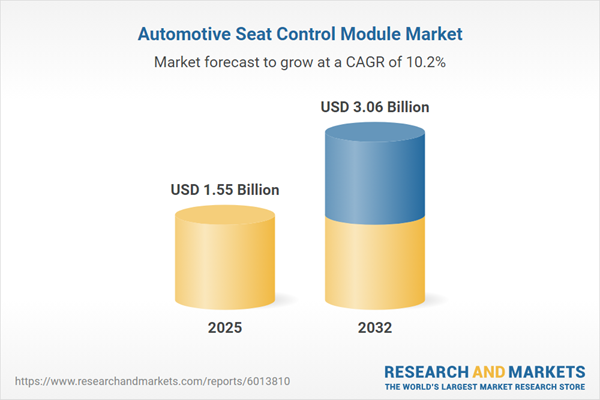Speak directly to the analyst to clarify any post sales queries you may have.
The automotive seat control module market is experiencing accelerated change as digitalization, regulatory mandates, and sustainability priorities redefine strategies across the value chain. Forward-thinking leaders are driving innovation and operational adaptation to remain competitive in this evolving landscape.
Market Snapshot: Automotive Seat Control Module Market
From 2024 to 2032, the automotive seat control module market is projected to grow significantly, advancing from USD 1.40 billion to USD 3.06 billion at a compound annual growth rate of 10.21%. This expansion is fueled by increasing investments in occupant wellness and a rising preference for innovative seating systems. Manufacturers are prioritizing seamless integration of digital technologies and compliance with updated regulations. As competition intensifies, market participants are pursuing differentiation through specialized research and delivering comfort-driven and safety-oriented solutions robust enough to support future industry requirements.
Scope & Segmentation
This report offers actionable intelligence into critical factors shaping the automotive seat control module sector. It provides a comprehensive breakdown of the market’s structural categories and technology enablers:
- Application: Examines trends in both original equipment manufacturers (OEMs) and aftermarket procurement, highlighting varying strategies across the supply landscape and evolving end-customer requirements.
- Mechanism Type: Explores the deployment of advanced electric seat controls, which elevate user experience and system efficiency, in contrast with legacy manual mechanisms still present within select vehicle classes.
- Vehicle Type: Investigates specific adoption patterns in commercial and passenger vehicles, linking differences in service expectations with shifting adoption rates of sophisticated seating technologies.
- Seat Position: Reviews innovation initiatives in both front and rear seat modules, underlining ergonomic developments and the integration of advanced safety enhancements distributed across various platforms.
- Feature: Assesses the prioritization of value-added capabilities such as lumbar support, programmable memory settings, massage systems, and integrated climate management, each targeting organizations focused on customization and elevated comfort.
- End User: Identifies distinct operational expectations and purchasing decision drivers for both fleet managers and individual buyers, which influence tailored aftersales and support strategies.
- Regions Covered: Delivers localized market analysis for the Americas, Europe, Middle East & Africa, and Asia-Pacific, drawing connections between regulatory standards and regional investment activities that shape demand and technology uptake.
- Key Companies Analyzed: Benchmarks leading firms such as Continental AG, Robert Bosch GmbH, ZF Friedrichshafen AG, DENSO Corporation, Lear Corporation, Magna International Inc., Adient plc, Faurecia S.E., Toyota Boshoku Corporation, and Brose Fahrzeugteile GmbH & Co. KG to deliver insights on evolving competitive dynamics.
Key Takeaways for Senior Decision-Makers
- Advanced integration of software and diagnostic solutions is boosting reliability and enhancing the support lifecycle of seat modules across regional markets.
- Industry push for sustainable practices is driving the adoption of recyclable materials and lightweight seat module designs to align with environmental targets and regulatory frameworks.
- Regional strategies differ: North America is progressing in connectivity and safety, Europe emphasizes ergonomics, while Asia-Pacific accelerates the rollout of personalization and next-generation features.
- Collaborations with technology and materials specialists enable streamlined product introduction and foster shared value between manufacturers and their partners, promoting collaborative innovation.
- Companies are broadening sourcing strategies through nearshoring and alliances, which reduce regulatory exposure and logistics bottlenecks, ultimately reinforcing enterprise supply chain resilience worldwide.
Tariff Impact and Supply Chain Considerations
Recent tariff changes in the United States on electronic and metallic components have led automotive seating suppliers to reevaluate and readjust sourcing practices. Many organizations are shifting toward nearshoring production and building adaptive logistics networks. These moves enhance cost control, limit operational risks, and create consistency in research and development planning despite dynamic regulatory shifts.
Methodology & Data Sources
The findings in this report stem from a synthesis of executive interviews, targeted industry analyses, and technical literature reviews. Reliable, multi-source data underpins recommendations, helping senior leaders develop strategies in product design, system integration, and international manufacturing oversight.
Why This Report Matters
- Provides actionable, sector-specific strategies for procurement, engineering, and operations leaders seeking to navigate a rapidly changing automotive seat control module environment.
- Offers guidance for strategic investment by mapping technology trends, critical features, and competitive market activity to improve decision-making and execution.
- Clarifies global supply chain challenges and evolving compliance requirements, equipping organizations to adapt effectively to new regulatory and regional demands.
Conclusion
As new technologies and evolving regulations redefine the automotive seat control module sector, success demands flexible leadership and proactive strategy. This report supports senior decision-makers in steering growth and promoting operational excellence.
Additional Product Information:
- Purchase of this report includes 1 year online access with quarterly updates.
- This report can be updated on request. Please contact our Customer Experience team using the Ask a Question widget on our website.
Table of Contents
3. Executive Summary
4. Market Overview
7. Cumulative Impact of Artificial Intelligence 2025
Companies Mentioned
The companies profiled in this Automotive Seat Control Module market report include:- Continental AG
- Robert Bosch GmbH
- ZF Friedrichshafen AG
- DENSO Corporation
- Lear Corporation
- Magna International Inc.
- Adient PLC
- Faurecia S.E.
- Toyota Boshoku Corporation
- Brose Fahrzeugteile GmbH & Co. KG
Table Information
| Report Attribute | Details |
|---|---|
| No. of Pages | 195 |
| Published | November 2025 |
| Forecast Period | 2025 - 2032 |
| Estimated Market Value ( USD | $ 1.55 Billion |
| Forecasted Market Value ( USD | $ 3.06 Billion |
| Compound Annual Growth Rate | 10.2% |
| Regions Covered | Global |
| No. of Companies Mentioned | 11 |









